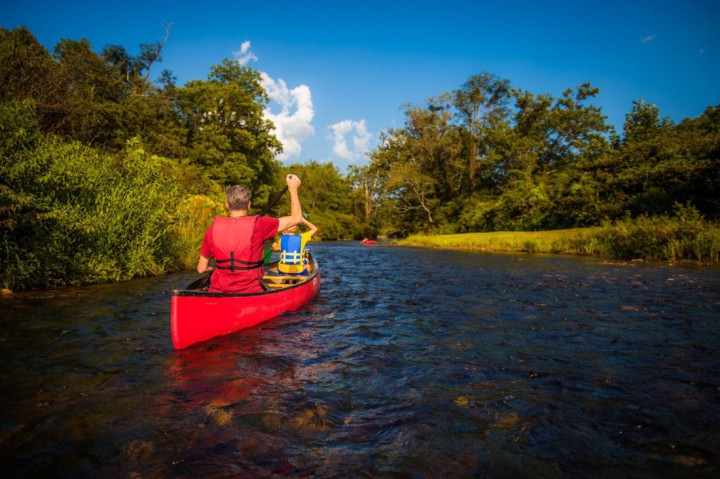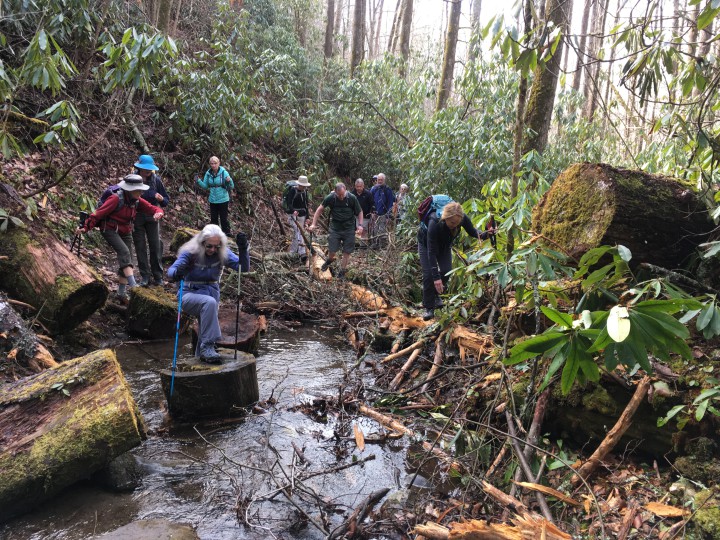Head into Pisgah National Forest on any day of the week, and you’ll find activity out on the trails. From hikers standing atop Max Patch bald, enjoying stunning views of Mount Mitchell, to mountain bikers riding beside white pine and mountain laurel on the Foster Creek Trail, outdoors enthusiasts take advantage of Pisgah as just one of Western North Carolina’s hot spots for recreation.
Over 1.6 million acres of national forest across the region beckon hikers, bikers, climbers, rafters and hunters, among others, to enjoy the outdoors. The Pisgah Conservancy, a nonprofit dedicated to the well-being of the Pisgah Ranger District, estimates that between 3 million and 4 million people visit Pisgah each year, roughly half of the 7 million annual visitors to all national forests in the state.
Recreation tourism is an undeniable driving force of the local economy. Last year, researchers from Eastern Kentucky University found that outdoor recreation in Pisgah and Nantahala national forests generated $115 million in annual spending, supporting jobs and attracting businesses. But as people flock to Western North Carolina to take advantage of the region’s abundant outdoor recreational opportunities, they also bring a human impact to wild places.
Making waves
Eric Bradford is the director of operations at Asheville GreenWorks, an environmental organization that focuses on the urban environment. For the past 45 years, Asheville GreenWorks has tracked the trash that comes into the French Broad River system. Bradford says that approximately 25 percent of this waste comes from individuals recreating on the river or throwing items directly into it.

“We see a lot of flip-flops, unopened beer cans, popped tubes and sunglasses,” says Bradford. “Most people aren’t intentionally littering, but all of those plastics are going to accumulate and start breaking down at some point into microplastics.”
When plastic waste enters the river, explains Bradford, the material becomes very brittle and breaks into tiny pieces as it flows into the Mississippi River and, eventually, the Gulf of Mexico. “[The microplastics] are highly toxic items that we are spreading into our ecosystem,” he says.
The science regarding the impact of microplastics on marine organisms is still emerging, but according to a 2015 study published in Marine Anthropogenic Litter titled “Microplastics in the Marine Environment: Distribution, Interactions and Effects,” their distribution is worldwide. Nanoscale plastic particles — billionths of a meter in size — can actually enter the cells of birds, fish, turtles, mammals and invertebrates, with impacts that are yet to be understood.
But Bradford is quick to add that recreation generally improves water quality. “People become advocates of the waterway. They don’t want to have a dirty waterway, and they aren’t going to leave it in a worse condition than when they started.”
Beaten paths
People also make their outdoor presence felt while recreating on dry land. Danny Bernstein is a member of the Carolina Mountain Club, an all-volunteer organization that leads hikes and maintains over 500 miles of trails in Western North Carolina. She says that physically impacting the land while hiking is unavoidable but counters that her club has a generally positive effect.
“We have people that really care about Pisgah and the Smokies because they put their feet on the ground once a week or more,” Bernstein says. “They are friends, they are supporters, and they monitor the various issues that affect public lands.”
Bernstein notes that the Carolina Mountain Club tries to hike responsibly. “We stay on the trail,” she says. “We do not throw anything in the woods, even if it’s biodegradable, because most of what we eat is not native.”
The club makes sure that hikers follow procedures while going to the bathroom in the outdoors, avoiding rivers and other water sources. Club members also carpool to the trailhead, limiting their carbon footprint.
But most of the practices that make hikers responsible users of the outdoors go hand in hand with respecting the forest, says Bernstein. “We talk about flowers or trees,” she says. “Sustainability comes naturally.”
Mark Stierwalt is a former board member for Pisgah Area SORBA, a mountain bike and trail advocacy group. While he acknowledges that mountain biking can disturb soils, he also notes that sustainable trail design can mitigate user impact.
On a physical level, those changes can include improving drainage structures to reduce soil transport and adding better sight lines. “Blind corners are safety and social issues on multi-use trails,” explains Stierwalt. “My biggest concern for the trail system is user conflicts. We have a major educational issue that is centered around [bike] yielding.”

Economically and socially, sustainable trail design means sharing stewardship and making trails accessible to everyone. As the Forest Service’s 2016 report on the National Strategy for a Sustainable Trail System explains it, a sustainable trail system should be supported by public and private interests in tandem and invite people of all ages, abilities and backgrounds to recreate outdoors.
Adding motors to the trail mix makes sustainability more challenging. The Grandfather Ranger District in the Pisgah National Forest and the Nantahala Ranger District in the Nantahala National Forest both offer trail systems for off-road driving by all-terrain and four-wheel-drive vehicles.
In 2008, the National Forest Service released a report on the effects of all-terrain vehicles on forested lands and grasslands. Following any level of disturbance by ATVs, trail runoff increased by 56 percent and generated sediment by 625 percent, compared to the undisturbed forest floor. However, the report also notes that this disturbance can be reduced by proper trail design and maintenance.
Doubling back
Notably, many of the trails currently in use were not initially designed for hiking or mountain biking. “Almost all of the trails in Pisgah and the Smokies weren’t built as trails [for recreation],” says Bernstein. “They were old roads or old trails from before they became public land,” she says.
Stierwalt says the land’s previous use for timber production led trail builders to seek the shortest distance between two points, which was often along creeks or “fall lines” straight down a slope. When it rains, water rushes down these fall line trails, picking up soil and depositing it into creeks below.
When this happens, the sediment damages water quality. Sedimentation can destroy fish spawning beds, reduce aquatic plant life and alter a stream’s ecology. “A lot of our issues are alignment issues rather than pure use issues,” says Stierwalt.
These issues may be exacerbated by what Stierwalt calls a coming “tidal wave” of demand for mountain biking trails. The sport has become popular with younger riders, who are training their skills to higher levels than those of previous generations. “They are going to be looking for harder and more technical terrain as they move toward adulthood — Pisgah is going to be a magnet for those riders,” notes Stierwalt.
Sustainable trail design will do a lot to help meet the upcoming demand, but Stierwalt says it’s only part of the answer. “Having a master plan for the district’s trail system would go a long way with planning for the future,” he says. “It would allow for better allocation of resources and take into account all user groups and subgroups.” But according to Stierwalt, there is currently no effort in the works to develop a master plan, which could come with a price tag in excess of $100,000.
Best foot forward
“When we go out in the woods, it doesn’t matter what we do. We are disrupting things,” says Colleen Olfenbuttel, black bear and furbearer biologist with the N.C. Wildlife Resources Commission. From trail construction that fragments wildlife habitat to hiker traffic that keeps bears from wild food sources, human activity in the wild has unavoidable consequences.
Even in light of these impacts, however, Olfenbuttel wants people to recreate in the outdoors. “Certainly, we want to encourage people to get out in the woods and enjoy nature,” says Olfenbuttel. “We understand people that appreciate nature and enjoy being outside will be more likely to support wildlife programs. I tell people: Leave no trace. Make the place cleaner than when you left it.”
John Cottingham, founder of the Pisgah Conservancy, says that people can take simple steps to lessen their impact on the environment while recreating. “Don’t go out on the trails when they are vulnerable,” he advises. “When we’ve had a freeze and thaw or heavy rain, things like mountain bikes, horses or even boot treads can have a negative impact.”
Cottingham also recommends that all users of Pisgah National Forest stop by the visitor’s center, located approximately two miles inside the Brevard entrance to the forest, and talk to the staff there for advice on current issues of concern.
“Moving forward, it is going to be really important for the entire community to come together and do a lot more volunteer trail work,” says Stierwalt. “I think it is fair to ask trail users to volunteer two to four times a year on trail days and give something back to the forest.”
For his part, Bradford advises those who want to recreate in the local waterways to take only what they need out on the river and to secure the items they do take. “Leave the flip-flops and wear a good pair of river sandals or old sneakers,” he says. “Strap on your sunglasses, lock your cooler. We want folks to leave out the things that are going to fall off your person really easily.”
Still, at the end of the day, Bradford encourages people to get out on the river. “Would I want a few less popped tubes in the river but have it dirtier in other aspects?” he asks. “No. I’d rather have the popped tubes and the people who are invested in the waterways.”



![1—20180129_151012_resized_1[70580]](https://mountainx.com/wp-content/uploads/2018/04/1—20180129_151012_resized_170580-1100x825.jpg)
Sorry, but no matter how you spin it mountain bikes tear up the trails….. just a fact.
As do hikers, equestrians, and OHVs. Sustainable trail design is the key, not specific user group impacts.
No mountain bikers have used the trails at Graveyard Fields, and those are the worst in western NC. ALL users have an impact.
How about the Pisgah National Forest Rangers check Looking Glass Rock and the Trail leading up to it. I understand the trail has to be moved due to erosion, but did they not consider the growth on the rock at the top decreases every year to the point that one or two persons have fallen to their death. I hiked that trail May 2017. It was the most disgusting hike I have ever gone on. One of the rocks at the top, is dedicated as a helipad (which is not fair!). Looking Glass Rock lost is beauty after 1992. Since Pisgah Forest is operated by the Dept. of Agriculture, they do not care. Someone from the Asheville office on
160 Zillicoa St , Asheville, NC 28801 (828) 257-4200. The big problem is too many rock climbers that disturb the peregrine falcon that nest in the rock. They actually carve a hole into the rock so that they can have they young. It is up to the person that climbs or rappels on Looking Glass Rock which face is legal to climb or rappel. But it really ruins the enjoyment of hiking the trail because there are no volunteers to take care of the rock which is overgrown with groundcover and new trees. It takes away the beauty of the Rock. And I do believe the Nation Forest in Asheville should do something. And they should stop the rock climbing so that the peregrine falcon can continue to have more falcons.